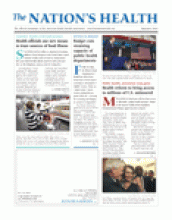The way women give birth in the United States might soon change, if new recommendations are accepted. Advocating expanded delivery options, an independent panel of experts convened by the National Institutes of Health in March determined that giving birth vaginally after a previous cesarean delivery is a reasonable option for certain women.
The panel found that pregnant women who want to have a vaginal birth after a cesarean delivery find few clinicians and facilities willing to allow them to attempt such a birth, also known as a “trial of labor.” Moreover, many women — even those at low risk for complications — are not offered a trial of labor after a previous cesarean delivery even though it is a reasonable option for them. The panel urged that current guidelines discouraging the procedure be revisited, that malpractice concerns be addressed and that additional research be undertaken to better understand the medical and non-medical factors that influence decision-making for women with previous cesarean deliveries.
According to the Centers for Disease Control and Prevention, the cesarean rate in the United States climbed 53 percent between 1996 and 2007, reaching an all-time high of 32 percent in 2007. The current overall cesarean delivery rate in the United States is 31 percent, with less than 10 percent of women giving birth vaginally after a previous cesarean, down from 28 percent in 1996.
“Declining (vaginal births after cesarean) rates and increasing cesarean delivery rates over the last 15 years would seem to indicate that planned repeat cesarean delivery is preferable to a trial of labor,” said F. Gary Cunningham, MD, chair of obstetrics and gynecology at the University of Texas Southwestern Medical Center at Dallas and chair of the consensus development panel. “But the currently available evidence suggests a very different picture: A trial of labor is worth considering and may be preferable for many women.”
A draft consensus statement released by the panel in March said a trial of labor is successful in nearly 75 percent of cases and maternal death is actually lower for women who have a trial of labor, regardless of whether they end up delivering vaginally or by cesarean. However, women who have an unsuccessful trial of labor and undergo a repeat cesarean delivery experience higher rates of illness than those who have a successful vaginal birth after cesarean.
For most of the 20th century, clinicians believed it was unsafe to give birth vaginally after a previous cesarean delivery, according to the consensus statement. But the cesarean rate began to fall after a consensus panel convened by NIH in 1980 questioned the necessity of routine repeat cesarean deliveries and outlined situations in which a vaginal procedure could be considered. As a result, from 1980 to 1996 the numbers of vaginal births after cesareans increased steadily. But acccording to the Coalition for Improving Maternity Services, cesarean rates across the nation began rising again in 1996 after the American College of Obstetricians and Gynecologists released new guidelines recommending that vaginal births after cesareans only be attempted in facilities equipped to respond to emergencies, with physicians immediately available to provide emergency care.
In its consensus statement, the independent panel urged clinicians to revisit the American College of Obstetricians and Gynecologists recommendation, noting that two recent surveys of hospital administrators found that 30 percent of hospitals stopped offering a trial of labor or vaginal birth after a previous cesarean because they were unable to meet the organization’s recommendation.
The panel called for additional research to develop clear, evidence-based risk assessment tools to assist mothers and providers in the decision-making process from early pregnancy through delivery.
“There’s still a lot we don’t know about which women will be successful in having a (vaginal birth after cesarean), but we believe it’s essential that women’s desires and preferences be respected throughout the decision-making process,” Cunningham said.
To view the panel’s draft consensus statement, visit www.consensus.nih.gov.
- Copyright The Nation’s Health, American Public Health Association









